Card Duty, Part 1
The Magic 2015 preview weeks are over, so that means it's time to start telling some card-by-card design stories. Note that, as this wasn't a set I worked on, my stories are going to be more about the designs themselves than the design process. Also, as we did something special by having outside designers, I thought it would be fun to take a look at all fifteen outside designs and talk a little about them from a design perspective. I'll point out which ones are the outside designers' cards as I get to them.

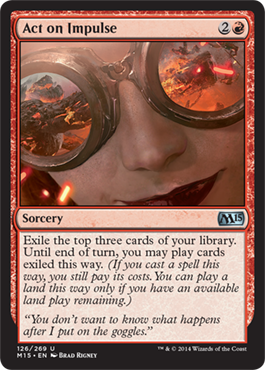
When Chandra, Pyromaster first appeared, I explained that her middle impulsive-drawing ability came out of discussions about red's slice of the color pie on my blog (called Blogatog—check it out) and it was something we were trying out in red. Well, I'm happy to say it has been a success, which means you're going to be seeing more cards with this ability in the future. This card came about because we asked ourselves "What would red's Ancestral Recall look like?"
The interesting thing about allowing you to draw more cards with this ability is that it scales down slightly as you get more cards because the turn restriction limits how much mana you have available to cast the spells. Another thing I really like about this ability is that it scales up over time, meaning it gets stronger the later in the game it is, because you tend to have more mana. Not a lot of red abilities do that and it's nice to help give red a little more late-game in-flavor resources.

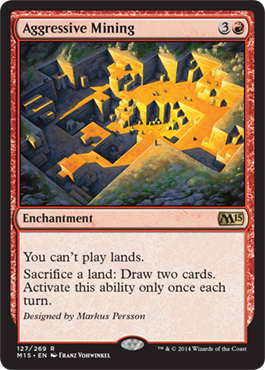
This is the first outside-designer card. It's designed by a man named Markus Persson, but he is probably better known by his nickname, "Notch." Markus is the creator of the game Minecraft and founder of the company Mojang. My son, Adam, by the way, is a huge Minecraft player, so the most excited I have ever seen him about any Magic news I have ever told him ever was when I revealed that Notch was making a Magic card. (So thank you, Notch, for making me a cool dad, if only for one night.)
When we chose to do this promotion, one of the things we decided was to allow the outside designers a little more latitude when designing their cards. They still had to go through our normal design and development processes, but because we wanted these cards to feel special, we allowed the designers to push boundaries a little more than we might normally allow an internal designer to do.
This card is a good example. Normally, red is fourth when it comes to card drawing (ahead of only white). We let red have looting and Winds of Change–style cards, but neither of these gain card advantage. We do the impulsive drawing (see above), which can allow card advantage, but has a small window of opportunity. Aggressive Milling is much more of a late-game card-drawing card. Marcus did a great job with the flavor. While red traditionally isn't a color that draws cards late game, he found a flavorful way to justify it and make it feel red. Yes, red can make this trade, but it's going to cause itself trouble down the road—very red.
The other thing I like about this card is that it helps solve a larger problem we've been having. Red, as a color, has a lot of things working against it in the Commander format. It tends to be aggressive, but that doesn't work as well in a format where everyone starts with double the life and multiple opponents capable of removing your threats. As such, red is always on the lookout for valuable late-game cards, and Marcus has provided us with a flavorful card for red that fits this bill.

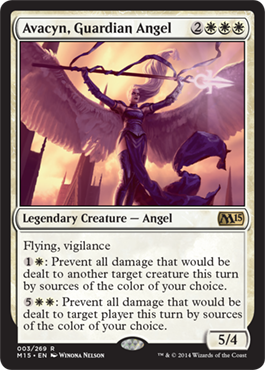
The design team decided they wanted this core set to have some legendary creatures, but not just any ones. How about some creatures the audience already knows? Making a second version of a known creature is always tricky, because you want it to feel different enough to warrant a new card but be similar enough that it feels like the same creature. I feel this new Avacyn does a good job of striking that balance. She has a protective flavor that mirrors her first incarnation but does it differently enough that this card has its own play style.

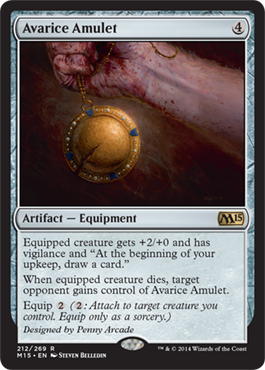
This is the second outside-designer card. It was designed by Mike Krahulik and Jerry Holkins, aka Gabe and Tycho from the webcomic Penny Arcade. This is a top-down design based on a running joke from their comic. (Gabe and Tycho continually "kill" one another over ownership of a Pac-Man watch.) To fit the flavor, the card had to be an Equipment and it needed the ability to move back and forth in ownership between players.
Now, if this card was an Aura, it would probably just move when the enchanted creature dies, but as it's an Equipment, it became a little trickier. The reason is because, to help separate Equipment from Auras, we made the choice to only allow players to equip artifacts to their own creatures. Also, for flavor reasons, it was nice for the card to actually change ownership.
I like the design because it grants a bonus to the creature that encourages attacking—increasing the chance that the equipped creature is killed—and it grants enough of a bonus that it makes the equipped creature a target for creature kill. The fun of this card is it getting passed back and forth many times. In fact, the thing I enjoy most about the design is that the top-down source was a story element and Mike and Jerry did a wonderful job of recreating that story in game-play terms. It's good to be equipped with the Avarice Amulet, so you are inclined to kill the creature wearing it so you can put it on one of your creatures. I always talk about how good designs create stories and Avarice Amulet is perfectly suited to do just that.

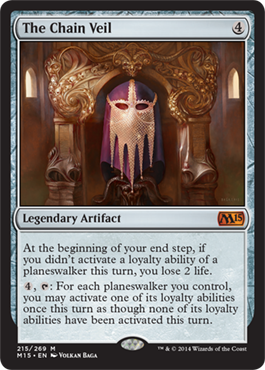
Garruk went bad. If you know your story, you'll know that this little artifact had a lot to do with it, so Magic 2015 felt like a good place to finally turn the Chain Veil into a card. The key to the design was to play it with Planeswalkers. Have one and the Planeswalker gets more powerful; but if you don't have one, well, the Chain Veil doesn't like that.
The Chain Veil is the first card we've made to let you mess around with Planeswalkers' loyalties. It's something players have been asking for forever, but it's dangerous territory, so we've been taking our time getting to it. The Chain Veil just seemed like too good an opportunity to pass up.

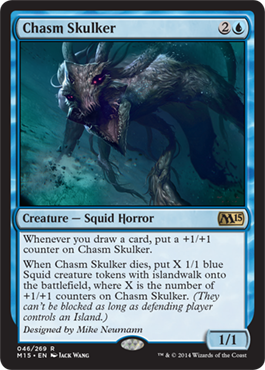
This is the third outside-designer card. It was designed by Mike Neumann. He is the creative director of Borderlands and works at Gearbox Software. This design has a few cool elements to it. First, it ties card drawing to growth, because the creature gets a +1/+1 counter for each card drawn. This fits well in blue because, to maximize the effect, it wants you having a lot of other sources of card draw. Yet, in a vacuum it still works, because the card draw worked in the natural play of the game. This means the card can be built around in Constructed but is still viable in Limited.
The card also has another cool feature, which is it has a built-in backup plan. If your opponent manages to somehow get rid of the Chasm Skulker, it provides a new problem—an army of 1/1 islandwalkers. The card does a nice job of tying these two elements together flavorfully, but what actually I most enjoy is that it creates these neat Johnny deck-building moments. Chasm Skulker both wants to have lots of card drawing but also make use of a lot of little 1/1 token creatures. How exactly do you do that? The card creates a neat deck-building challenge.
This is something I would love for us to do a little more—create cards that have unique, quirky flavor that push players to figure out how best to maximize the disparate, yet flavorful, elements.

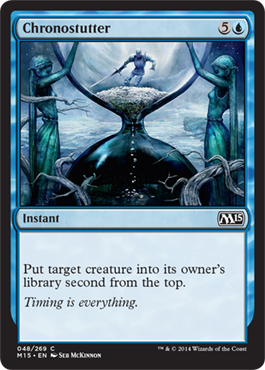
When I talk about the color pie, I know it sounds sometimes like there are master meetings about ever little nuance about the color pie and each ability is carefully allocated. That's not exactly how it works. You see, people make cards and, with time, things will start to drift. It's easy to justify mechanics with flavor, so in a vacuum, it's not hard for a card to just feel right. But once you start looking at various cards in conjunction, you start to see confusion, where the game isn't quite sure what color a certain effect is. One such example is putting a card from the battlefield on top of its owner's library.
Green has done it. Black has done it. I'm sure red could find a chaos justification if we let it. But the case we found ourselves in was that we were making both white and blue cards that were putting cards from the battlefield on top of the library and/or several cards from the top of the library. White justified it as a delay tactic while blue treated it like a super unsummoning.
When conflicts like this arise, we bring them to our weekly Cardcrafting meeting, where R&D talks about technical issues. The group decided this was an ability used infrequently enough that it didn't make sense for two different colors to do it, so we started a discussion about which color should get it. Both sides were well fought, but, in the end, blue was victorious, as it felt more like super unsummoning than a delay tactic. So, moving forward, you'll be seeing effects like this in blue rather than in white.

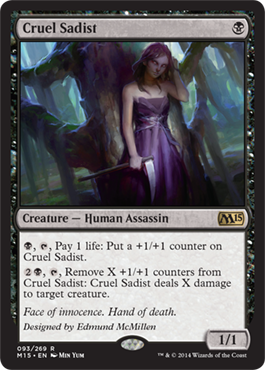
This is the fourth outside-designer card. It was designed by Edmund McMillen. He is the designer of Binding of Isaac and Super Meat Boy and was featured in Indie Game: The Movie. This is a card that plays around with resources—what I call an engine card. It can convert life into +1/+1 counters (limited to being played on Cruel Sadist) and +1/+1 counters into damage on creatures. I like that both abilities require tapping because, while I like the idea that the card can convert life to creature damage, it's problematic if it's too easy or too fast.
I also really enjoy how the first ability is exciting all by itself. Do I want to pay life and tap my creature to make it bigger or do I want to attack with it? It's quite possible if I designed this card, I might have stopped there. It's a flavorful ability that plays well all by itself. But then, I get to design Magic cards all the time. Edmund only got one card, so he wanted to (rightfully so) add a little more. The second ability converts the growth into potential damage, although at the cost of shrinking back down.
When you combine these two abilities, you get a creature with a lot of options. Now, we have to be careful how many creatures like this we do because the board state would get very complex if there were a lot of cards like Cruel Sadist on the battlefield, but having it as a splashy rare is a lot of fun.
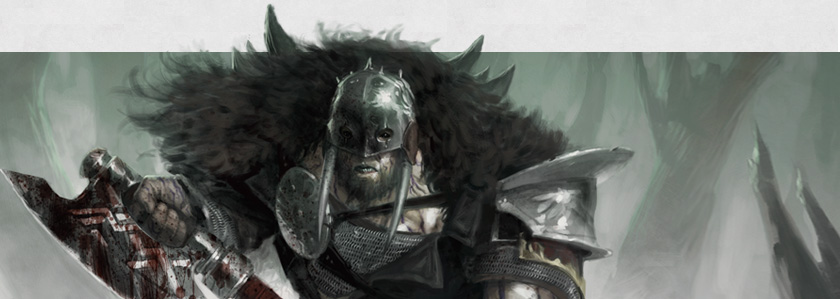
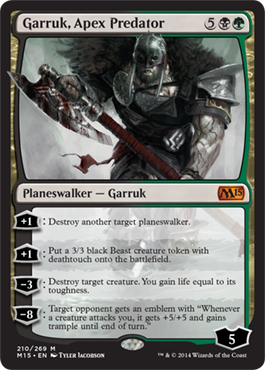
If you've looked at a box of Magic 2015 or poster of Magic 2015 or just about anything remotely related to the marketing of the set, you might get a hint that Garruk is in the set. Garruk has gone bad and plays the role of the big bad of Magic 2015. That meant we had to deliver a card that could live up to the hype.
How exactly could we do that? For starters, we chose to make Garruk two colors. Nicol Bolas, Planeswalker was the only multicolor Planeswalker to ever appear in a core set and he was a reprint. What if Garruk was the first brand-new multicolor Planeswalker to appear in a core set?
Garruk is clearly both green and black now, so that seemed to be a good choice.
Next, we had to hammer home the apex-hunter flavor. Garruk had gone from hunting animals to hunting Planeswalkers. Okay, what if one of his + abilities killed Planeswalkers? Pretty splashy. The design/development team then worked hard to make sure all the abilities came together to make Garruk read as a predator, overall.
All of this was good, but we needed one last splashy thing. Was there something we had ever done before with Planeswalkers that we had, up to now, never repeated? Why yes, there was.
Remember this card? Jace, the Mind Sculptor was the one and only time we had put four abilities on a single Planeswalker (okay, okay, Garruk Relentless/Garruk the Veil-Cursed had four—well, five, actually, but that was over two sides). What if we chose to have Garruk, Apex Predator do four abilities for the second time? Done!
And that is how we made the big bad Planeswalker for Magic 2015.

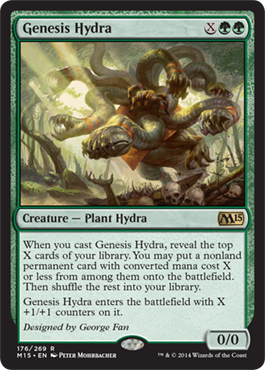
A couple years ago, I had the pleasure of meeting this next outside designer (number five, if you're counting), George Fan. George is the designer of Plants vs. Zombies. You probably could tell I'm a fan of the game because I made a nod to the game on a card when I designed Innistrad.
George even inspired me to write one of my favorite designer-y articles, called "Piggybacking." So, obviously, I was quite excited to see what George came up with when given the chance to make his own Magic card. He did not disappoint. For starters, I love creatures with variable power and toughness, especially when there's an X in the mana cost. Over the years, I've made a bunch of them, most often in green, with the design name Creatureball. But that's just where George starts. George also dusts off an effect from a popular green card from not that long ago.
What if you not only got a giant Hydra but also got a goody to come along with it? And the bigger your Hydra, the bigger your goody potentially can be. Five years ago, I wrote an article on randomness where I talked about how the best randomness is something where there is unknown but mostly upside. You get to open a present and, while you don't know exactly what it is, it's something you assume you're going to want. Great designs make great stories and Genesis Hydra does not disappoint. George also gets style points for making it a Plant Hydra.

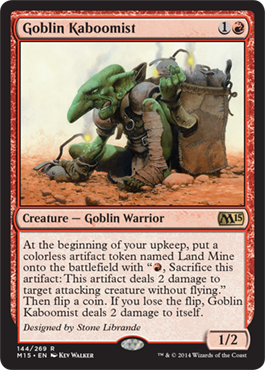
This is the sixth outside-designer card. It was designed by Stone Librande. He is lead designer at Riot Games, was the designer of Diablo 3 and the creative director of SimCity. Goblin Kaboomist is a design after my own heart. After all, I made this card:
Stone does a perfect job of capturing what I love about a good Goblin design. It conveys the essence of being a goblin. The Goblin Kaboomist has a job and if that job is done correctly, he's going to be pretty potent. There's only one problem—did I mention he's a Goblin? Stone messes around with something we actually haven't done that much with—artifact tokens. Not artifact creature tokens (Richard did that back in Alpha), artifact tokens. The Goblin Kaboomist is laying mines. And mines used effectively are pretty dangerous.
But each time the Goblin Kaboomist lays the mine, he has a 50/50 chance of screwing it up and then—BOOM! But, and here's where the design adds in some deck building, the Goblin Kaboomist's toughness is exactly 2, meaning if you can enhance his toughness in any way, he can survive his own mistakes. So the card is both flavorful and fun while being a nice build-around card.

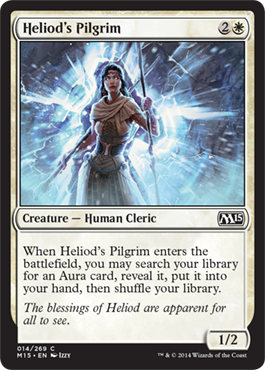
Magic 2015 takes place on six different planes (to tie into the planes used in Duels of the Planeswalkers). As one of those planes is Theros, it allowed the designers of the set a chance to throw some bones to Standard by making a few Theros-block-relevant cards. Heliod's Pilgrim is a great example. For all intents and purposes, this card could have been in any of the Theros-blocksets.
This is one of the advantages of a core set. Because the set isn't defined by a single world, it has the ability to add cards to themes before and after it. After it? Well, while I am not at liberty to tell you which cards were made to play nicely with Khans of Tarkir block, I can say that it is normal practice for us to make sure that a handful of cards in each core set play nicely not just with the current environment, but the future environment as well. Feel free to look and see if you can figure out which cards those are.

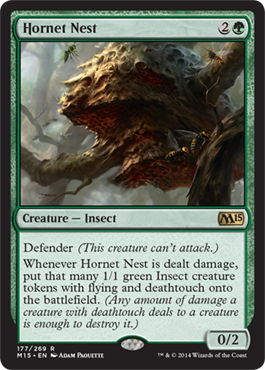
Let me officially state this for the record: Bees and Hornets will be the end of me. While I have nothing personally against bees and hornets in real life, in Magic they have been the justification for all sorts of color bleed in green. (For some reason, I can't convince anyone else that they should be white—come on someone, read about bees.) This newest approach is to make bees 1/1 flying creatures with deathtouch.
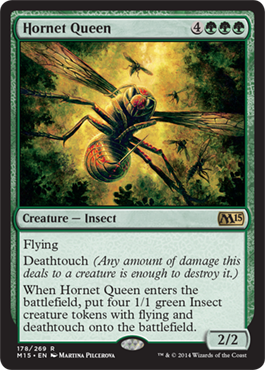
Okay, we're getting closer to actual green cards. I'm not crazy about the flying (although at least they're small) and I can do without cards making four+ token creatures with deathtouch, but at least I feel like we're moving in the right direction. All I ask is, think about white...

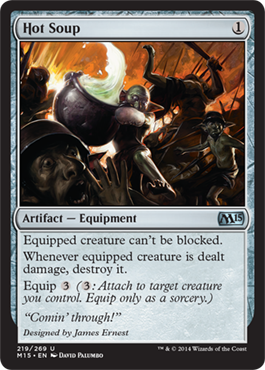
How many people can you name who have both designed a Magic card and also illustrated a Magic card? Both Jesper Myrfors and I have designed a card and illustrated it (Elves of Deep Shadow and Look at Me, I'm the DCI, respectively). Matt Cavotta has illustrated many cards and designed a few while on the design team for Future Sight. Hot Soup adds a fourth member to this list. (And yes, there's a very good chance I'm forgetting someone.) Hot Soup is the seventh outside-designer card. It was designed by James Ernest, owner and lead designer of Cheapass Games. James has designed many, many games, with Kill Doctor Lucky being one of his most famous.
What a lot of you might not know is that, many years ago, James worked at Wizards of the Coast. During that time, he was able to wrangle the opportunity to illustrate a Magic card. This Magic card:
His card, Reality Twist, was from Ice Age, which means there was a nineteen-year gap between James illustrating a Magic and designing a Magic card. Luckily, it was well worth the wait. I mentioned earlier that we gave the designers a little more flexibility when making their cards. This is a card that stretches not only mechanical limitations, but creative ones. In the early years of Magic , we did a lot sillier things creatively and over the years have narrowed the tone of the game. The game still has plenty of humor, but we do a bit less "silly." Well, there was no way to do James's card without the accompanying creative. Hot Soup, which was James's name, really only works if it's Hot Soup.
So Aaron Forsythe himself went to the creative team with this card and said, "I know this stretches what we normally do creatively, but for this promotion do you mind?" The creative team was aboard, so all of you now get Hot Soup. The design was obviously top-down, but mechanically it plays well, so it was the perfect marriage of function and flavor.
Out of Time
The card-by-card articles run by pretty fast, but I've hit my word limit for the week. That means you will all have to come back next week for Part 2. As always, I am eager for any feedback on today's article. You can email me, respond to this article's thread, or talk to me through any of my social media (Twitter, Tumblr, Google+, and Instagram). See you all next week.
Until then, may you have a job fun enough that others want a chance to do it.
"Drive to Work #136 & 137—Rise of the Eldrazi, Parts 2 & 3"
Today's two podcasts are parts two and three of a five-part series about the design of the final set of the Zendikar block, Rise of the Eldrazi.
- Episode 137 : Rise of the Eldrazi, Part 3 (13.6 MB)
- Episode 136 : Rise of the Eldrazi, Part 2 (16.6 MB)
- Episode 135 : Rise of the Eldrazi, Part 1 (16.3 MB)
- Episode 134 : Art (15.9 MB)
- Episode 133 : Designing Commons (14.2 MB)
- Complete Drive To Work Podcast Archive

